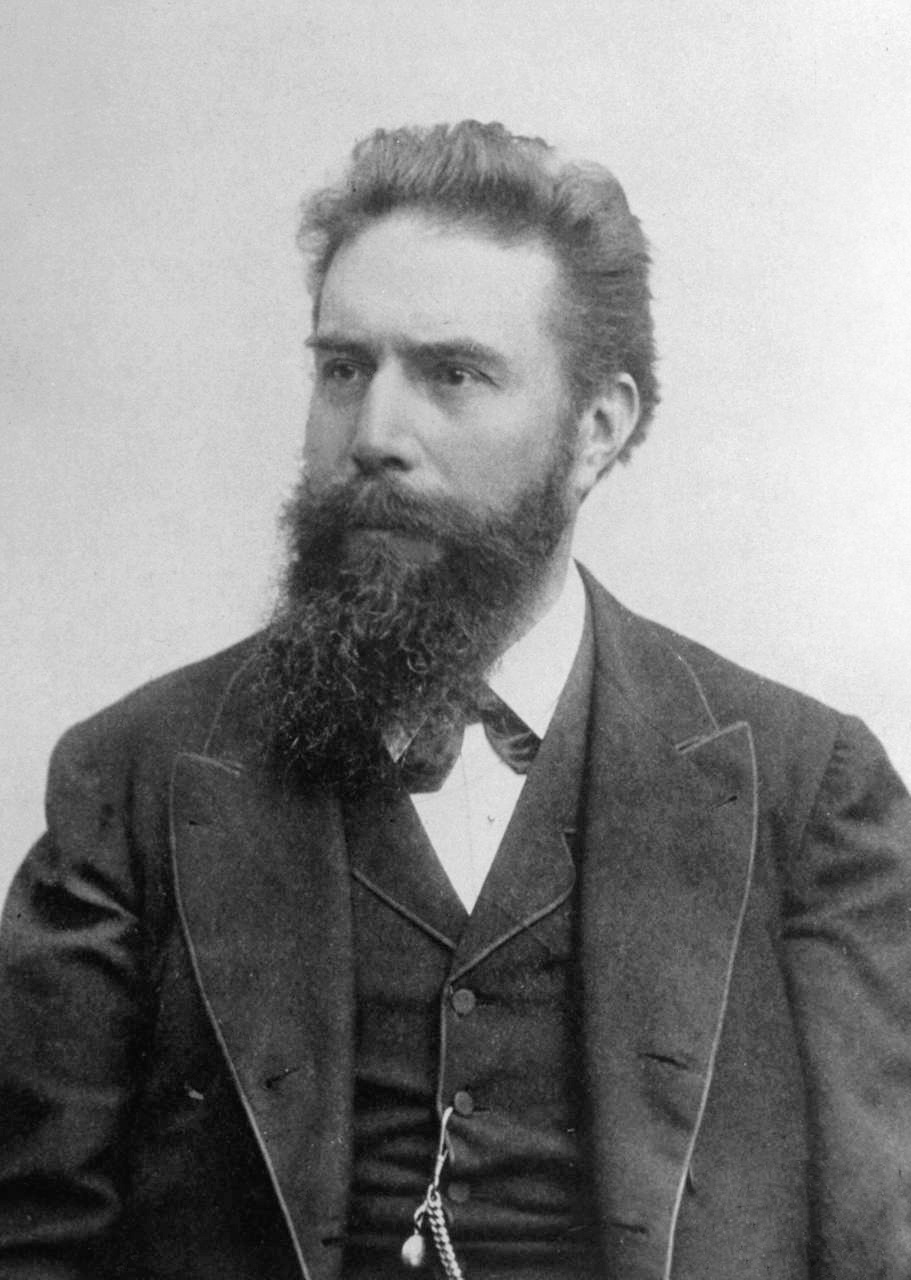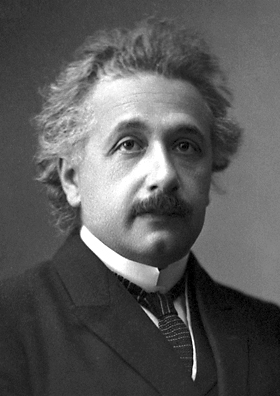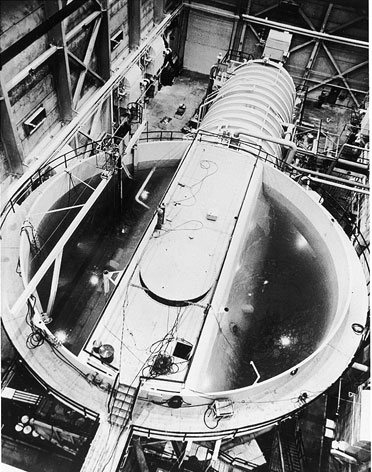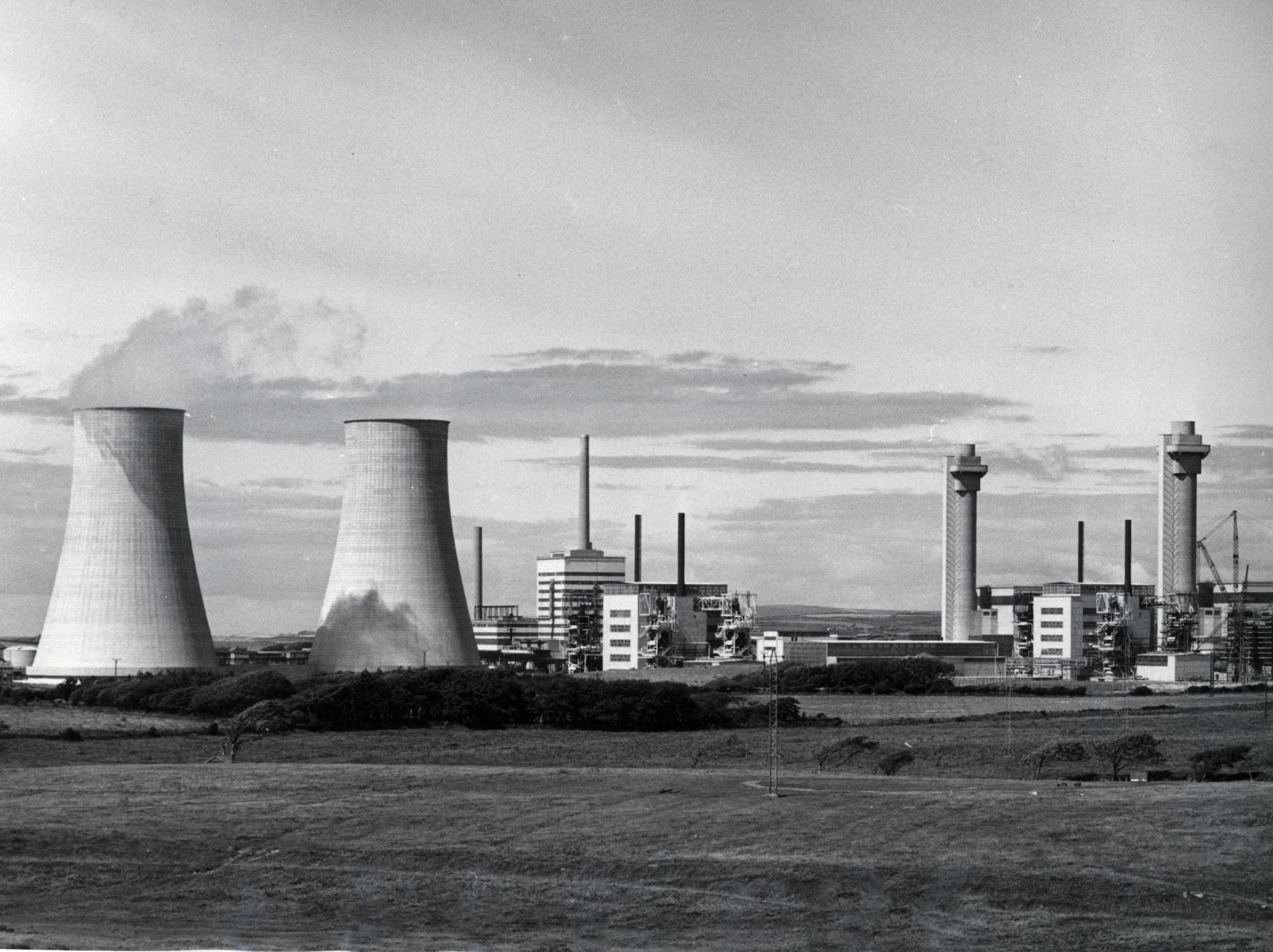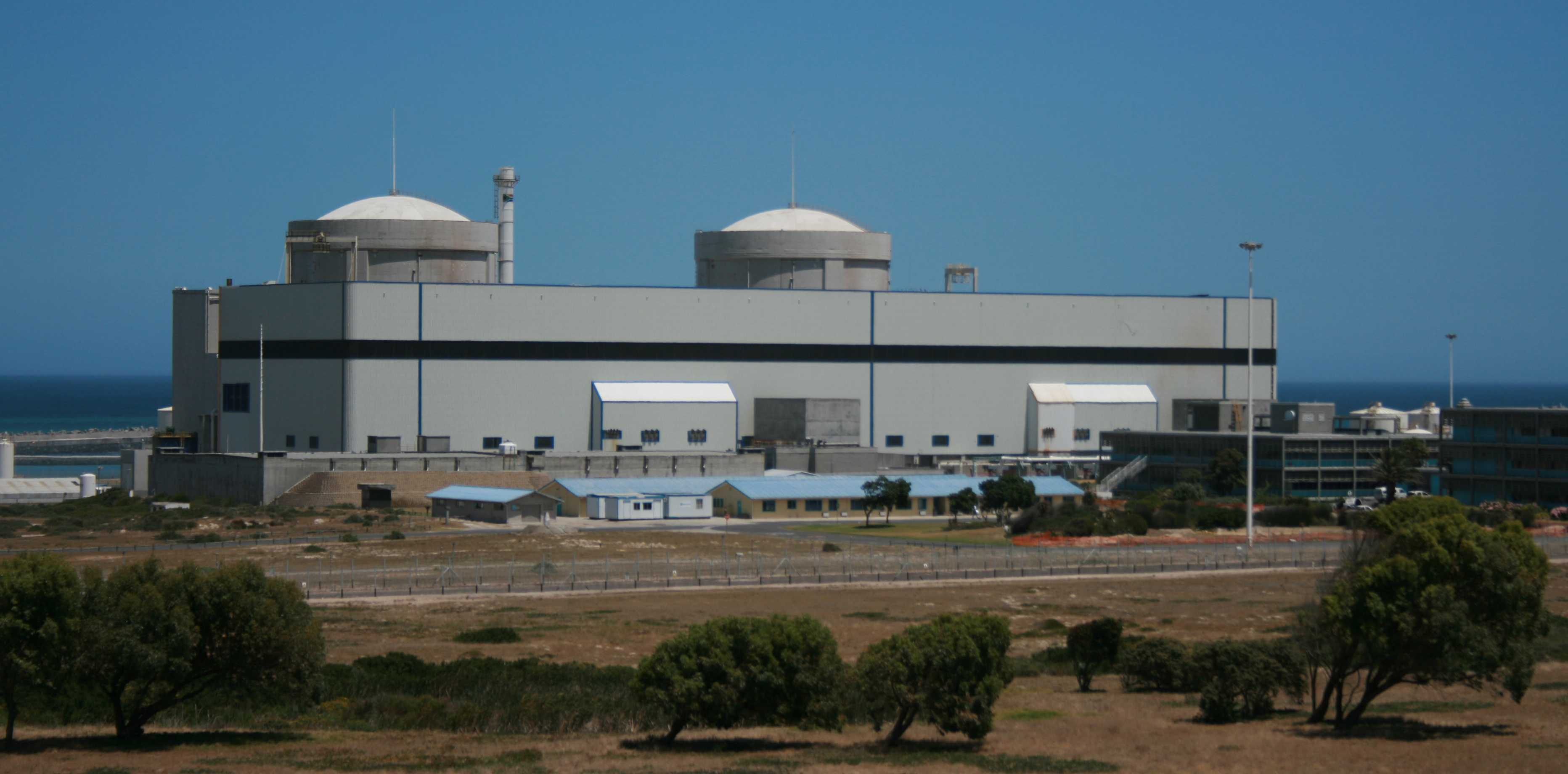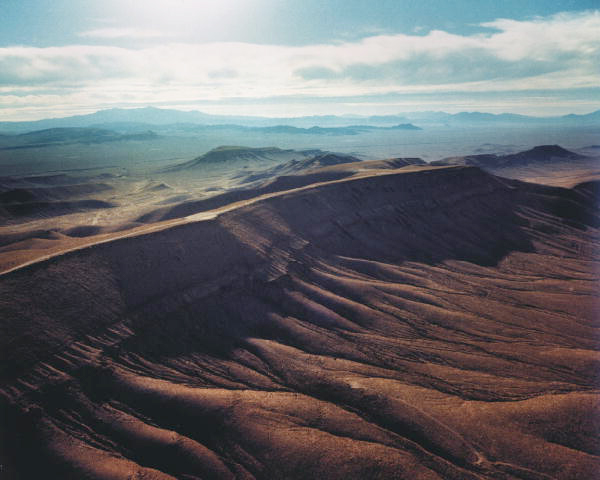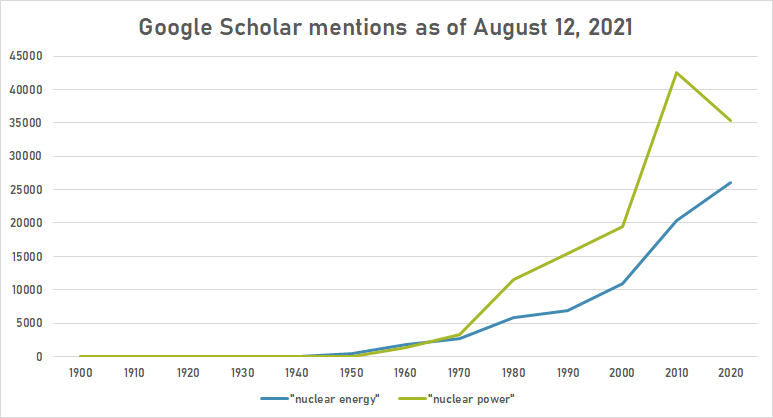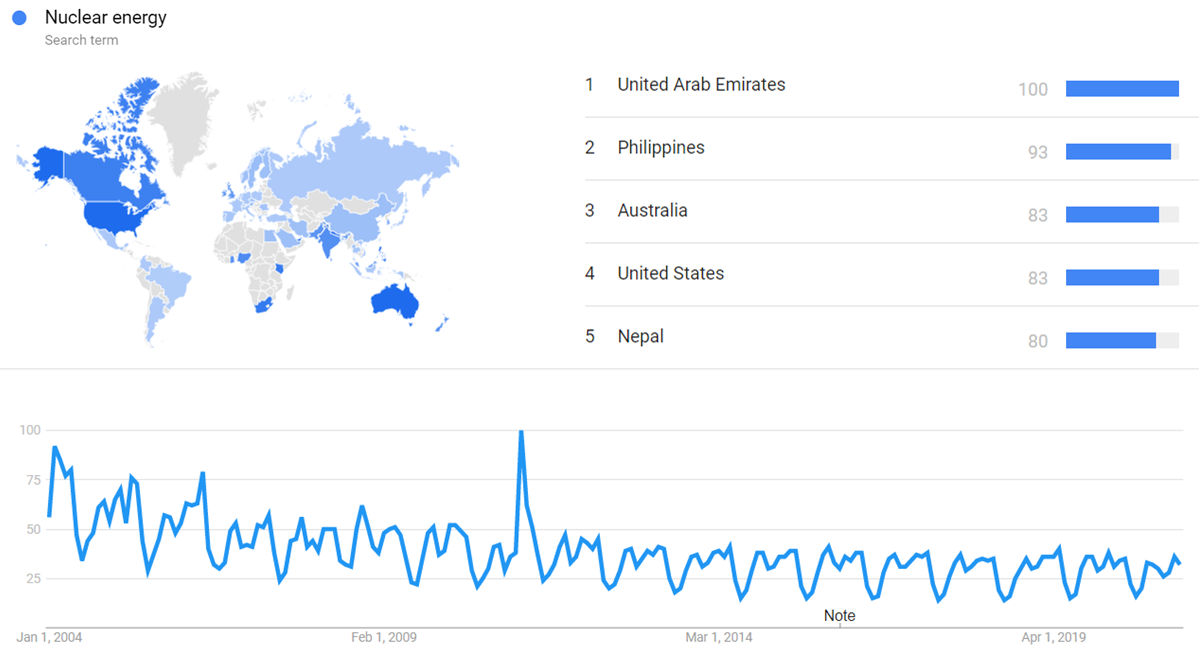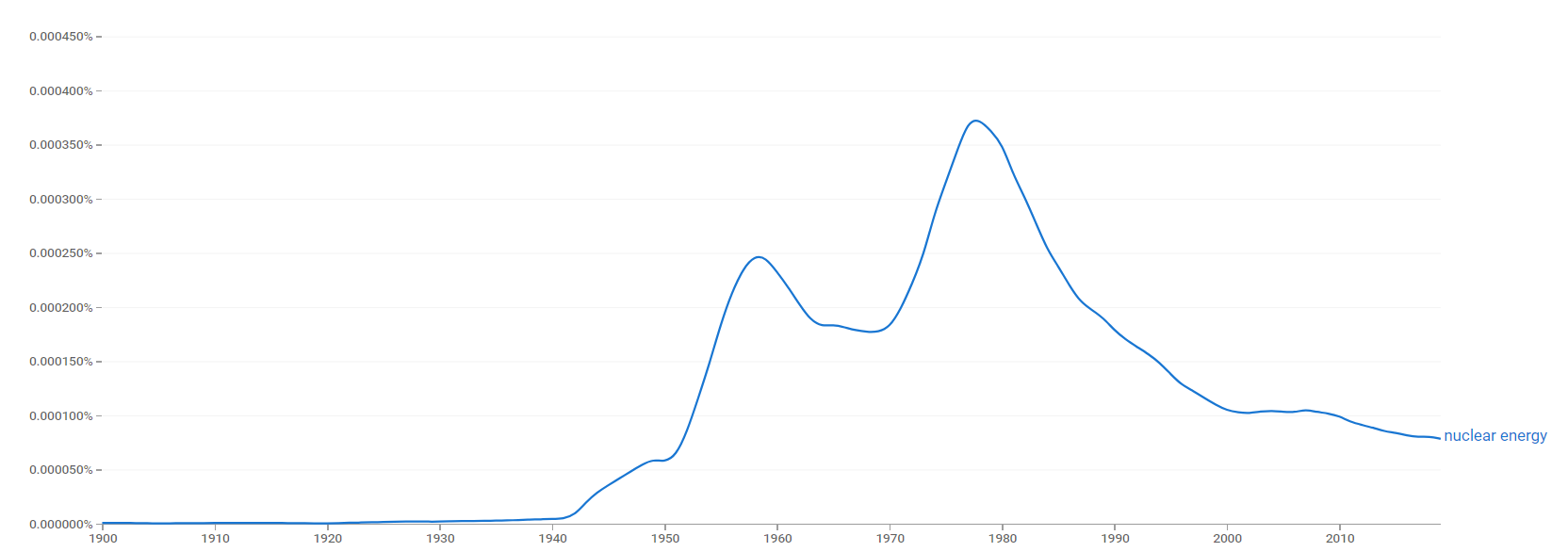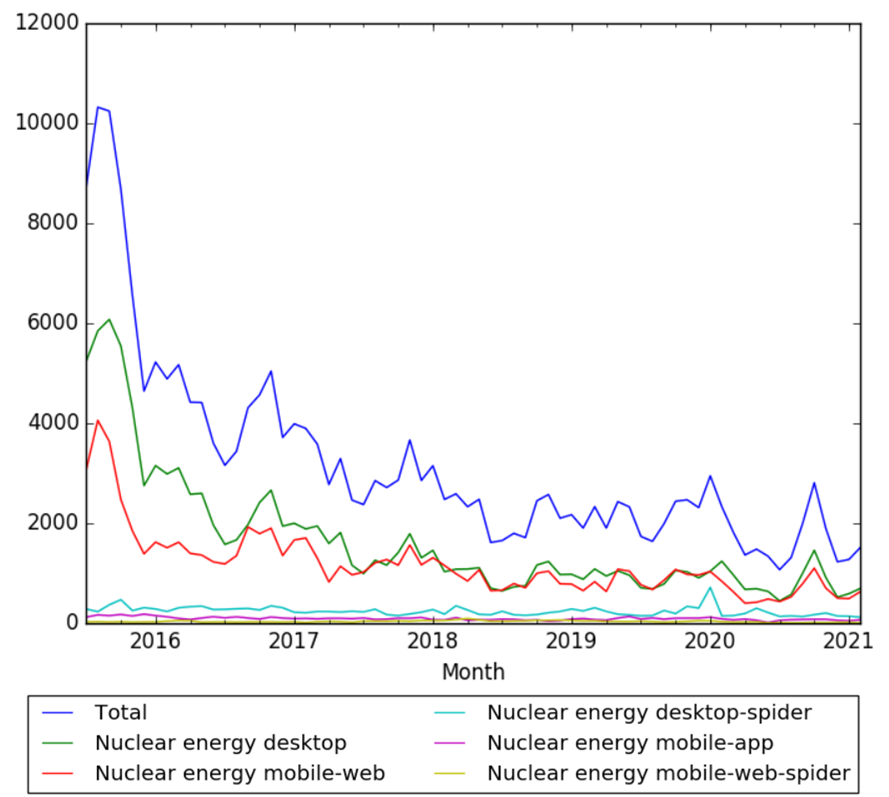Difference between revisions of "Timeline of nuclear energy"
(→Full timeline) |
|||
| (52 intermediate revisions by the same user not shown) | |||
| Line 29: | Line 29: | ||
|- | |- | ||
|} | |} | ||
| + | |||
==Full timeline== | ==Full timeline== | ||
| Line 35: | Line 36: | ||
! Year !! Event type !! Details !! Country | ! Year !! Event type !! Details !! Country | ||
|- | |- | ||
| − | | 1789 || Scientific development || German chemist {{w|Martin Klaproth}} discovers {{w|uranium}} and names it after the planet Uranus.<ref name="Outline History of Nuclear Energy">{{cite web|title=Outline History of Nuclear Energy|url=http://www.world-nuclear.org/information-library/current-and-future-generation/outline-history-of-nuclear-energy.aspx|website=world-nuclear.org|accessdate=9 December 2017}}</ref> || {{w|Germany}} | + | | 1789 || Scientific development || German chemist {{w|Martin Klaproth}} discovers {{w|uranium}} and names it after the planet Uranus.<ref name="Outline History of Nuclear Energy">{{cite web|title=Outline History of Nuclear Energy|url=http://www.world-nuclear.org/information-library/current-and-future-generation/outline-history-of-nuclear-energy.aspx|website=world-nuclear.org|accessdate=9 December 2017}}</ref> Uranium (U) is a radioactive element with atomic number 92, belonging to the actinoid series of the periodic table. It is a crucial nuclear fuel, constituting about two parts per million of the Earth's crust. Key uranium minerals include {{w|pitchblende}}, {{w|uraninite}}, {{w|carnotite}}, {{w|autunite}}, and {{w|torbernite}}. These minerals, rich sources of nuclear fuels, possess significantly more energy compared to known fossil fuel deposits.<ref>{{cite web |title=Uranium {{!}} Definition, Properties, Uses, & Facts {{!}} Britannica |url=https://www.britannica.com/science/uranium |website=www.britannica.com |access-date=12 November 2023 |language=en |date=22 September 2023}}</ref> || {{w|Germany}} ({{w|Kingdom of Prussia}}) || [[File:Martin Heinrich Klaproth.jpg|thumb|center|100px]] |
|- | |- | ||
| − | | 1895 || Scientific development || German physicist {{w|Wilhelm Röntgen}} discovers {{w|X-rays}}.<ref>{{cite book|last1=Longair|first1=Malcolm|title=Maxwell's Enduring Legacy|url=https://books.google.com.ar/books?id=OkRyDAAAQBAJ&pg=PA124&dq=%22in+1895%22+%22R%C3%B6ntgen%22+%22x-rays%22&hl=en&sa=X&ved=0ahUKEwj8krPfnIvYAhWGFZAKHZsWB_4Q6AEIJzAA#v=onepage&q=%22in%201895%22%20%22R%C3%B6ntgen%22%20%22x-rays%22&f=false|accessdate=15 December 2017}}</ref><ref>{{cite book|last1=Suryanarayana|first1=C.|title=Experimental Techniques in Materials and Mechanics|url=https://books.google.com.ar/books?id=HRvSBQAAQBAJ&pg=PA18&dq=%22in+1895%22+%22R%C3%B6ntgen%22+%22x-rays%22&hl=en&sa=X&ved=0ahUKEwj8krPfnIvYAhWGFZAKHZsWB_4Q6AEILTAB#v=onepage&q=%22in%201895%22%20%22R%C3%B6ntgen%22%20%22x-rays%22&f=false|accessdate=15 December 2017}}</ref><ref>{{cite book|last1=Mould|first1=R.F|title=A Century of X-Rays and Radioactivity in Medicine: With Emphasis on Photographic Records of the Early Years|url=https://books.google.com.ar/books?id=IXPz7bVR7g0C&pg=PT25&dq=%22in+1895%22+%22R%C3%B6ntgen%22+%22x-rays%22&hl=en&sa=X&ved=0ahUKEwj8krPfnIvYAhWGFZAKHZsWB_4Q6AEIMzAC#v=onepage&q=%22in%201895%22%20%22R%C3%B6ntgen%22%20%22x-rays%22&f=false|accessdate=15 December 2017}}</ref><ref name="Imaging in Drug Discovery and Early Clinical Trials">{{cite book|last1=Rudin|first1=Markus|title=Imaging in Drug Discovery and Early Clinical Trials|url=https://books.google.com.ar/books?id=4xOko-MuyDYC&pg=PA17&dq=%22in+1895%22+%22R%C3%B6ntgen%22+%22x-rays%22&hl=en&sa=X&ved=0ahUKEwj8krPfnIvYAhWGFZAKHZsWB_4Q6AEIOTAD#v=onepage&q=%22in%201895%22%20%22R%C3%B6ntgen%22%20%22x-rays%22&f=false|accessdate=15 December 2017}}</ref><ref name="Outline History of Nuclear Energy"/><ref name="History of Nuclear Energy whatisnuclear.com">{{cite web|title=History of Nuclear Energy|url=https://whatisnuclear.com/articles/nuclear_history.html|website=whatisnuclear.com|accessdate=14 December 2017}}</ref> || {{w|Germany}} | + | | 1895 || Scientific development || German physicist {{w|Wilhelm Röntgen}} discovers {{w|X-rays}}, marking a groundbreaking moment in science and medicine. His experiments with {{w|Crookes tube}}s leads to the revelation of these invisible rays capable of penetrating most substances while making bones and metals visible. Roentgen's meticulous research and subsequent presentations quickly spreads worldwide, leading to the development of medical applications and public fascination. Despite facing initial challenges in his scientific career, Roentgen's altruism and dedication earns him the first {{w|Nobel Prize in physics}} in 1901. His refusal of patents would ensure widespread access to X-ray technology, demonstrating his commitment to scientific advancement over personal gain.<ref>{{cite web |title=November 8, 1895: Roentgen's Discovery of X-Rays |url=https://www.aps.org/publications/apsnews/200111/history.cfm |website=www.aps.org |access-date=25 March 2024 |language=en}}</ref><ref>{{cite book|last1=Longair|first1=Malcolm|title=Maxwell's Enduring Legacy|url=https://books.google.com.ar/books?id=OkRyDAAAQBAJ&pg=PA124&dq=%22in+1895%22+%22R%C3%B6ntgen%22+%22x-rays%22&hl=en&sa=X&ved=0ahUKEwj8krPfnIvYAhWGFZAKHZsWB_4Q6AEIJzAA#v=onepage&q=%22in%201895%22%20%22R%C3%B6ntgen%22%20%22x-rays%22&f=false|accessdate=15 December 2017}}</ref><ref>{{cite book|last1=Suryanarayana|first1=C.|title=Experimental Techniques in Materials and Mechanics|url=https://books.google.com.ar/books?id=HRvSBQAAQBAJ&pg=PA18&dq=%22in+1895%22+%22R%C3%B6ntgen%22+%22x-rays%22&hl=en&sa=X&ved=0ahUKEwj8krPfnIvYAhWGFZAKHZsWB_4Q6AEILTAB#v=onepage&q=%22in%201895%22%20%22R%C3%B6ntgen%22%20%22x-rays%22&f=false|accessdate=15 December 2017}}</ref><ref>{{cite book|last1=Mould|first1=R.F|title=A Century of X-Rays and Radioactivity in Medicine: With Emphasis on Photographic Records of the Early Years|url=https://books.google.com.ar/books?id=IXPz7bVR7g0C&pg=PT25&dq=%22in+1895%22+%22R%C3%B6ntgen%22+%22x-rays%22&hl=en&sa=X&ved=0ahUKEwj8krPfnIvYAhWGFZAKHZsWB_4Q6AEIMzAC#v=onepage&q=%22in%201895%22%20%22R%C3%B6ntgen%22%20%22x-rays%22&f=false|accessdate=15 December 2017}}</ref><ref name="Imaging in Drug Discovery and Early Clinical Trials">{{cite book|last1=Rudin|first1=Markus|title=Imaging in Drug Discovery and Early Clinical Trials|url=https://books.google.com.ar/books?id=4xOko-MuyDYC&pg=PA17&dq=%22in+1895%22+%22R%C3%B6ntgen%22+%22x-rays%22&hl=en&sa=X&ved=0ahUKEwj8krPfnIvYAhWGFZAKHZsWB_4Q6AEIOTAD#v=onepage&q=%22in%201895%22%20%22R%C3%B6ntgen%22%20%22x-rays%22&f=false|accessdate=15 December 2017}}</ref><ref name="Outline History of Nuclear Energy"/><ref name="History of Nuclear Energy whatisnuclear.com">{{cite web|title=History of Nuclear Energy|url=https://whatisnuclear.com/articles/nuclear_history.html|website=whatisnuclear.com|accessdate=14 December 2017}}</ref> || {{w|Germany}} || [[File:Roentgen2.jpg|thumb|center|100px]] |
|- | |- | ||
| − | | 1896 || Scientific development || French phycisist {{w| | + | | 1896 || Scientific development || French phycisist {{w|Henri Becquerel}} becomes the first to discover evidence of {{w|radioactivity}}. The name of the phenomenon is given by Pierre and Marie Curie.<ref name="Outline History of Nuclear Energy"/><ref name="Imaging in Drug Discovery and Early Clinical Trials"/><ref name="History of Nuclear Energy whatisnuclear.com"/> || {{w|France}} || [[File:Portrait of Antoine-Henri Becquerel.jpg|thumb|center|100px]] |
|- | |- | ||
| − | | 1898 || Scientific development || [[w:Pierre Curie|Pierre]] and {{w|Marie Curie}} isolate {{w|polonium}} and {{w|radium}} from the {{w|pitchblende}}.<ref name="Outline History of Nuclear Energy"/> || {{w|France}} | + | | 1898 || Scientific development || [[w:Pierre Curie|Pierre]] and {{w|Marie Curie}} isolate {{w|polonium}} and {{w|radium}} from the {{w|pitchblende}}.<ref name="Outline History of Nuclear Energy"/> || {{w|France}} || [[File:Portraits of Marie Curie and Pierre Curie Wellcome V0027528.jpg|thumb|center|200px]] |
|- | |- | ||
| 1898 || Scientific development || Samuel Prescott shows that radiation destroys bacteria in food.<ref name="Outline History of Nuclear Energy"/> || | | 1898 || Scientific development || Samuel Prescott shows that radiation destroys bacteria in food.<ref name="Outline History of Nuclear Energy"/> || | ||
|- | |- | ||
| − | | 1899 || Scientific development || New Zealand-born British {{w|physicist}} {{w|Ernest Rutherford}} distinguishes alpha and beta radiation and discovers {{w|Half-life}}.<ref name="History of Nuclear Energy whatisnuclear.com"/> || {{w|United Kingdom}} | + | | 1899 || Scientific development || New Zealand-born British {{w|physicist}} {{w|Ernest Rutherford}} distinguishes alpha and beta radiation and discovers {{w|Half-life}}.<ref name="History of Nuclear Energy whatisnuclear.com"/> || {{w|United Kingdom}} || [[File:Ernest Rutherford LOC.jpg|thumb|center|100px]] |
|- | |- | ||
| − | | 1900 || Scientific development || French scientist {{w|Paul Ulrich Villard}} discovers {{w|gamma rays}} while studying the {{w|radiation}} emanating from {{w|radium}}.<ref name="Outline History of Nuclear Energy"/> || | + | | 1900 || Scientific development || French scientist {{w|Paul Ulrich Villard}} discovers {{w|gamma rays}} while studying the {{w|radiation}} emanating from {{w|radium}}.<ref name="Outline History of Nuclear Energy"/> || {{w|France}} || [[File:Paul Villard.jpg|thumb|center|100px]] |
|- | |- | ||
| 1902-1919 || Scientific development || {{w|Ernest Rutherford}} shows that {{w|radioactivity}} as a spontaneous event emitting an alpha or beta particle from the nucleus creates a different element. Rutherford would go on to develop a fuller understanding of atoms and in 1919 he manages to fire {{w|alpha particle}}s from a radium source into {{w|nitrogen}} and finds that nuclear rearrangement is occurring, with formation of oxygen.<ref name="Outline History of Nuclear Energy"/><ref name="The History Of Nuclear Energy"/><ref name="History of Nuclear Energy whatisnuclear.com"/> || {{w|United Kingdom}} | | 1902-1919 || Scientific development || {{w|Ernest Rutherford}} shows that {{w|radioactivity}} as a spontaneous event emitting an alpha or beta particle from the nucleus creates a different element. Rutherford would go on to develop a fuller understanding of atoms and in 1919 he manages to fire {{w|alpha particle}}s from a radium source into {{w|nitrogen}} and finds that nuclear rearrangement is occurring, with formation of oxygen.<ref name="Outline History of Nuclear Energy"/><ref name="The History Of Nuclear Energy"/><ref name="History of Nuclear Energy whatisnuclear.com"/> || {{w|United Kingdom}} | ||
|- | |- | ||
| − | | 1905 || Scientific development || {{w|Albert Einstein}} publishes paper putting forward the equivalence between mass and energy.<ref name="Outline History of Nuclear Energy"/> || {{w|Germany}} | + | | 1905 || Scientific development || German-born theoretical physicist {{w|Albert Einstein}} publishes paper putting forward the equivalence between {{w|mass}} and {{w|energy}}, introducing the world to the iconic equation [[w:Mass–energy equivalence|''E''=''mc''<sup>2</sup>]] through two articles on the {{w|special theory of relativity}}. The first paper, completed in June, focuses on the properties of light and time. Three months later, he publishes a second, shorter article as an {{w|addendum}}, revealing a "very interesting conclusion" about energy. Einstein presents his mathematical findings, stating that energy (E) is equal to mass (m) times the speed of light (c) squared (2), i.e., ''E''=''mc''<sup>2</sup>. The equation is foundational in understanding the relationship between mass and energy, and its practical applications would have significant implications in the field of nuclear energy, both in power generation and weaponry.<ref name="Outline History of Nuclear Energy"/><ref>{{cite web |title=The most famous equation in the world, E=mc2, arrived rather quietly. |url=https://www.amnh.org/exhibitions/einstein/energy |website=amnh.org |access-date=2 December 2023}}</ref><ref>{{cite web |last1=Smith |first1=Nathan |title=Research Guides: Annus Mirabilis of Albert Einstein: The 1905 Papers |url=https://guides.loc.gov/einstein-annus-mirabilis/1905-papers |website=guides.loc.gov |access-date=2 December 2023 |language=en}}</ref> || {{w|Germany}} || [[File:Albert Einstein (Nobel).png|thumb|center|100px]] |
|- | |- | ||
| 1911 || Scientific development || English radiochemist {{w|Frederick Soddy}} discovers that naturally-radioactive elements have a number of different {{w|isotope}}s ({{w|radionuclide}}s), with the same chemistry. In the same year, Hungarian radiochemist {{w|George de Hevesy}} shows that such radionuclides are invaluable as tracers, because minute amounts can readily be detected with simple instruments.<ref name="Outline History of Nuclear Energy"/> || {{w|United Kingdom}} | | 1911 || Scientific development || English radiochemist {{w|Frederick Soddy}} discovers that naturally-radioactive elements have a number of different {{w|isotope}}s ({{w|radionuclide}}s), with the same chemistry. In the same year, Hungarian radiochemist {{w|George de Hevesy}} shows that such radionuclides are invaluable as tracers, because minute amounts can readily be detected with simple instruments.<ref name="Outline History of Nuclear Energy"/> || {{w|United Kingdom}} | ||
| Line 80: | Line 81: | ||
|- | |- | ||
| 1942 || Scientific development || {{w|Enrico Fermi}} and Hungarian-born American physicist {{w|Leo Szilard}} measure neutron multiplication, concluding that a nuclear chain reaction is possible. That year, the couple creates the Chicago Pile-1, Chicago University.<ref name="History of Nuclear Energy whatisnuclear.com"/> || {{w|United States}} | | 1942 || Scientific development || {{w|Enrico Fermi}} and Hungarian-born American physicist {{w|Leo Szilard}} measure neutron multiplication, concluding that a nuclear chain reaction is possible. That year, the couple creates the Chicago Pile-1, Chicago University.<ref name="History of Nuclear Energy whatisnuclear.com"/> || {{w|United States}} | ||
| + | |- | ||
| + | | 1942 || || The {{w|Chicago Pile-1}} is built by {{w|Enrico Fermi}} and {{w|Leo Szilard}}. It is the world's first artificial nuclear reactor. || {{w|United States}} ||[[File:Stagg Field reactor.jpg|thumb|center|200px|{{w|Chicago Pile-1}}]] | ||
|- | |- | ||
| 1942 (December 2) || Scientific development || {{w|Manhattan Project}}: The world's first nuclear chain reaction takes place in {{w|Chicago}}.<ref name="Nuclear Power History: Timeline From Inception To Fukushima">{{cite web|title=Nuclear Power History: Timeline From Inception To Fukushima|url=https://www.huffingtonpost.com/2012/06/13/timeline-nuclear-power-history-fukushima_n_1593278.html|website=huffingtonpost.com|accessdate=9 December 2017}}</ref><ref name="The History Of Nuclear Energy"/> || {{w|United States}} | | 1942 (December 2) || Scientific development || {{w|Manhattan Project}}: The world's first nuclear chain reaction takes place in {{w|Chicago}}.<ref name="Nuclear Power History: Timeline From Inception To Fukushima">{{cite web|title=Nuclear Power History: Timeline From Inception To Fukushima|url=https://www.huffingtonpost.com/2012/06/13/timeline-nuclear-power-history-fukushima_n_1593278.html|website=huffingtonpost.com|accessdate=9 December 2017}}</ref><ref name="The History Of Nuclear Energy"/> || {{w|United States}} | ||
| Line 95: | Line 98: | ||
| 1951 || Technology || {{w|Experimental Breeder Reactor I}} starts up in {{w|Idaho}} and produces the world’s first useable electric power from nuclear energy, illuminating four light bulbs.<ref name="Nuclear Power History: Timeline From Inception To Fukushima"/> || {{w|United States}} | | 1951 || Technology || {{w|Experimental Breeder Reactor I}} starts up in {{w|Idaho}} and produces the world’s first useable electric power from nuclear energy, illuminating four light bulbs.<ref name="Nuclear Power History: Timeline From Inception To Fukushima"/> || {{w|United States}} | ||
|- | |- | ||
| − | | 1952 || Weapon || The first {{w|hydrogen bomb}} is tested by the {{w|United States}}.<ref>{{cite book|last1=Gottfrid Swedin|first1=Eric|title=Science in the Contemporary World: An Encyclopedia|url=https://books.google.com.ar/books?id=LJQjKkphxjUC&pg=PA138&dq=%22in+1952%22+%22first+hydrogen+bomb%22&hl=en&sa=X&ved=0ahUKEwjbiMyD_qbYAhVBDJAKHQvCBqUQ6AEILDAB#v=onepage&q=%22in%201952%22%20%22first%20hydrogen%20bomb%22&f=false|accessdate=26 December 2017}}</ref> || | + | | 1952 || Weapon || The first {{w|hydrogen bomb}} is tested by the {{w|United States}} in {{w|Enewetak Atoll}}, under {{w|codename}} {{w|Ivy Mike}}.<ref>{{cite book|last1=Gottfrid Swedin|first1=Eric|title=Science in the Contemporary World: An Encyclopedia|url=https://books.google.com.ar/books?id=LJQjKkphxjUC&pg=PA138&dq=%22in+1952%22+%22first+hydrogen+bomb%22&hl=en&sa=X&ved=0ahUKEwjbiMyD_qbYAhVBDJAKHQvCBqUQ6AEILDAB#v=onepage&q=%22in%201952%22%20%22first%20hydrogen%20bomb%22&f=false|accessdate=26 December 2017}}</ref> || {{w|United States}} || [[File:"Ivy Mike" atmospheric nuclear test - November 1952 - Flickr - The Official CTBTO Photostream.jpg|thumb|center|110px]] |
|- | |- | ||
| 1953 (December 8) || || United States president Dwight D. Eisenhower gives {{w|Atoms for Peace}} speech to the {{w|UN General Assembly}} in {{w|New York City}}, launching civilian program.<ref name="History of Nuclear Energy whatisnuclear.com"/> || {{w|United States}} | | 1953 (December 8) || || United States president Dwight D. Eisenhower gives {{w|Atoms for Peace}} speech to the {{w|UN General Assembly}} in {{w|New York City}}, launching civilian program.<ref name="History of Nuclear Energy whatisnuclear.com"/> || {{w|United States}} | ||
|- | |- | ||
| − | | 1954 || Power plant || The {{w|Soviet Union}} opens the 5 MW {{w|Obninsk Nuclear Power Plant}}, the first nuclear power plant to produce electricity for a {{w|power grid}}.<ref name="Nuclear Power History: Timeline From Inception To Fukushima"/> || {{w|Russia}} | + | | 1954 || Power plant || The {{w|Soviet Union}} opens the 5 MW {{w|Obninsk Nuclear Power Plant}}, the first nuclear power plant to produce electricity for a {{w|power grid}}.<ref name="Nuclear Power History: Timeline From Inception To Fukushima"/> || {{w|Russia}} || [[File:RIAN archive 409173 World's first nuclear power plant in Obninsk.jpg|thumb|center|180px|Obninsk Nuclear Power Plant Museum]] |
|- | |- | ||
| − | | 1955 || Submarine || The {{w|USS Nautilus (SSN-571)}} launches as the first nuclear-powered submarine.<ref name="History of Nuclear Energy whatisnuclear.com"/> || {{w|United States}} | + | | 1955 || Submarine || The {{w|USS Nautilus (SSN-571)}} launches as the first nuclear-powered submarine.<ref name="History of Nuclear Energy whatisnuclear.com"/> || {{w|United States}} || [[File:Nautilus core.jpg|thumb|center|100px|Nautilus reactor core]] |
|- | |- | ||
| 1955 (August 8–20) || Conference || The first United Nations International Conference on the Peaceful Uses of Atomic Energy is hosted in {{w|Geneva}}.<ref name="The History Of Nuclear Energy"/> || {{w|Switzerland}} | | 1955 (August 8–20) || Conference || The first United Nations International Conference on the Peaceful Uses of Atomic Energy is hosted in {{w|Geneva}}.<ref name="The History Of Nuclear Energy"/> || {{w|Switzerland}} | ||
|- | |- | ||
| − | | 1956 || Power plant || {{w|Calder Hall}} opens in {{w|Sellafield}}, {{w|England}}. It is the first commercial nuclear power station for civil use.<ref name="History of nuclear power corporate.vattenfall.com"/><ref name="Nuclear Power History: Timeline From Inception To Fukushima"/> || {{w|United Kingdom}} | + | | 1956 || Power plant || {{w|Calder Hall}} opens in {{w|Sellafield}}, {{w|England}}. It is the first commercial nuclear power station for civil use.<ref name="History of nuclear power corporate.vattenfall.com"/><ref name="Nuclear Power History: Timeline From Inception To Fukushima"/> || {{w|United Kingdom}} || [[File:HD.15.003 (11824034284).jpg|thumb|center|150px]] |
|- | |- | ||
| − | | 1956 || Power plant || {{w|Marcoule Nuclear Site}} is commissioned by the French nuclear program, generating its first electricity.<ref name="Nuclear Power History: Timeline From Inception To Fukushima"/> || {{w|France}} | + | | 1956 || Power plant || {{w|Marcoule Nuclear Site}} is commissioned by the French nuclear program, generating its first electricity.<ref name="Nuclear Power History: Timeline From Inception To Fukushima"/> || {{w|France}} || [[File:CEA Marcoule Site.jpg|thumb|center|170px|{{w|Marcoule Nuclear Site}}]] |
|- | |- | ||
| 1957 || Power plant || The United States completes its first large-scale nuclear power plant in {{w|Shippingport, Pennsylvania}}.<ref name="Nuclear Power History: Timeline From Inception To Fukushima"/><ref name="The History Of Nuclear Energy"/> || {{w|United States}} | | 1957 || Power plant || The United States completes its first large-scale nuclear power plant in {{w|Shippingport, Pennsylvania}}.<ref name="Nuclear Power History: Timeline From Inception To Fukushima"/><ref name="The History Of Nuclear Energy"/> || {{w|United States}} | ||
|- | |- | ||
| − | | 1957 (July 29) || Organization || The {{w|International Atomic Energy Agency}} is established with aims at promoting the peaceful use of nuclear energy.<ref name="Timeline of Nuclear Energy"/> || | + | | 1957 (July 29) || Organization || The {{w|International Atomic Energy Agency}} is established with aims at promoting the peaceful use of nuclear energy.<ref name="Timeline of Nuclear Energy"/> || || [[File:International Atomic Energy Agency Logo.svg|thumb|center|100px]] |
|- | |- | ||
| − | | 1959 || Power plant || The | + | | 1959 || Power plant || The {{w|Dresden Generating Station}} is commissioned in {{w|Illinois}}. It is the first nuclear plant built without government funding.<ref>{{cite book|last1=Skrabec|first1=Quentin R.|title=The 100 Most Significant Events in American Business: An Encyclopedia|url=https://books.google.com.ar/books?id=IBYJbFS52f0C&pg=PA230&dq=1959+Power+plant+The+first+nuclear+plant+built+without+government+funding+is+completed+in+Dresden,+Illinois.&hl=en&sa=X&ved=0ahUKEwiWpOGU_6bYAhWBWpAKHbTxA8wQ6AEIJzAA#v=onepage&q=1959%20Power%20plant%20The%20first%20nuclear%20plant%20built%20without%20government%20funding%20is%20completed%20in%20Dresden%2C%20Illinois.&f=false|accessdate=26 December 2017}}</ref> || {{w|United States}} || [[File:Dresden 1 inside.jpg|thumb|center|200px|Inside the Dresden 1 nuclear power plant]] |
|- | |- | ||
| − | | 1960 || Power plant || {{w|Yankee Rowe Nuclear Power Station}} starts operation in {{w|Rowe, Massachusetts}}, using the first fully commercial PWR of 250 MWe, designed by Westinghouse.<ref name="Outline History of Nuclear Energy"/> || {{w|United States}} | + | | 1960 || Power plant || {{w|Yankee Rowe Nuclear Power Station}} starts operation in {{w|Rowe, Massachusetts}}, using the first fully commercial PWR of 250 MWe, designed by Westinghouse.<ref name="Outline History of Nuclear Energy"/> || {{w|United States}} || [[File:Yankee Rowe.jpg|thumb|center|150px]] |
|- | |- | ||
| − | | 1961 (November 22) || Transportation || The {{w|United States Navy}} commissions the world’s largest ship, the {{w|USS Enterprise (CVN-65)}}, a nuclear-powered aircraft carrier with the ability to operate at speeds upto 30 knots for distances up to 740,800 kilometers without refueling.<ref name="The History Of Nuclear Energy"/> || {{w|United States}} | + | | 1961 (November 22) || Transportation || The {{w|United States Navy}} commissions the world’s largest ship, the {{w|USS Enterprise (CVN-65)}}, a nuclear-powered aircraft carrier with the ability to operate at speeds upto 30 knots for distances up to 740,800 kilometers without refueling.<ref name="The History Of Nuclear Energy"/> || {{w|United States}} || [[File:USS Enterprise (CVN-65) underway in the Atlantic Ocean on 14 June 2004 (040614-N-0119G-020).jpg|thumb|center|150px]] |
| − | |- | ||
| − | |||
|- | |- | ||
| 1965 || || The {{w|United States}} launches the first {{w|nuclear reactor}} in [[w:Outer space|space]].<ref>{{cite book|last1=Angelo|first1=Joseph A.|title=Encyclopedia of Space and Astronomy|url=https://books.google.com.ar/books?id=VUWno1sOwnUC&pg=PA563&dq=%221965%22+%22nuclear+reactor%22+%22space%22&hl=en&sa=X&ved=0ahUKEwikwOv_tK7YAhXCgJAKHfJ4AQ8Q6AEILTAB#v=onepage&q=%221965%22%20%22nuclear%20reactor%22%20%22space%22&f=false|accessdate=29 December 2017}}</ref><ref>{{cite book|last1=Cleveland,|first1=Cutler J.|last2=Morris|first2=Christopher G.|title=Handbook of Energy: Chronologies, Top Ten Lists, and Word Clouds|url=https://books.google.com.ar/books?id=ScL77rOCZn0C&pg=PA643&dq=%221965%22+%22nuclear+reactor%22+%22space%22&hl=en&sa=X&ved=0ahUKEwikwOv_tK7YAhXCgJAKHfJ4AQ8Q6AEIJzAA#v=onepage&q=%221965%22%20%22nuclear%20reactor%22%20%22space%22&f=false|accessdate=29 December 2017}}</ref><ref>{{cite book|last1=Angelo|first1=Joseph A.|title=The Facts on File Dictionary of Space Technology, Revised Edition|url=https://books.google.com.ar/books?id=kEjNBGzDDfEC&pg=PA383&dq=%22in+1965%22+%22nuclear+reactor%22+%22space%22&hl=en&sa=X&ved=0ahUKEwjMzt6Zta7YAhUKDJAKHYdiCbIQ6AEIMjAC#v=onepage&q=%22in%201965%22%20%22nuclear%20reactor%22%20%22space%22&f=false}}</ref> || {{w|United States}} | | 1965 || || The {{w|United States}} launches the first {{w|nuclear reactor}} in [[w:Outer space|space]].<ref>{{cite book|last1=Angelo|first1=Joseph A.|title=Encyclopedia of Space and Astronomy|url=https://books.google.com.ar/books?id=VUWno1sOwnUC&pg=PA563&dq=%221965%22+%22nuclear+reactor%22+%22space%22&hl=en&sa=X&ved=0ahUKEwikwOv_tK7YAhXCgJAKHfJ4AQ8Q6AEILTAB#v=onepage&q=%221965%22%20%22nuclear%20reactor%22%20%22space%22&f=false|accessdate=29 December 2017}}</ref><ref>{{cite book|last1=Cleveland,|first1=Cutler J.|last2=Morris|first2=Christopher G.|title=Handbook of Energy: Chronologies, Top Ten Lists, and Word Clouds|url=https://books.google.com.ar/books?id=ScL77rOCZn0C&pg=PA643&dq=%221965%22+%22nuclear+reactor%22+%22space%22&hl=en&sa=X&ved=0ahUKEwikwOv_tK7YAhXCgJAKHfJ4AQ8Q6AEIJzAA#v=onepage&q=%221965%22%20%22nuclear%20reactor%22%20%22space%22&f=false|accessdate=29 December 2017}}</ref><ref>{{cite book|last1=Angelo|first1=Joseph A.|title=The Facts on File Dictionary of Space Technology, Revised Edition|url=https://books.google.com.ar/books?id=kEjNBGzDDfEC&pg=PA383&dq=%22in+1965%22+%22nuclear+reactor%22+%22space%22&hl=en&sa=X&ved=0ahUKEwjMzt6Zta7YAhUKDJAKHYdiCbIQ6AEIMjAC#v=onepage&q=%22in%201965%22%20%22nuclear%20reactor%22%20%22space%22&f=false}}</ref> || {{w|United States}} | ||
|- | |- | ||
| − | | 1970 (March 5) || Treaty || The {{w|United States}}, {{w|United Kingdom}}, {{w|Soviet Union}}, and 45 other nations ratify the {{w|Treaty | + | | 1970 (March 5) || Treaty || The {{w|United States}}, {{w|United Kingdom}}, {{w|Soviet Union}}, and 45 other nations ratify the {{w|Treaty on the Non-Proliferation of Nuclear Weapons}}.<ref name="The History Of Nuclear Energy"/> || |
|- | |- | ||
| 1972 || Reactor || The world's first commercial prototype fast neutron reactor (the BN-350) started up in {{w|Kazakhstan}}, producing 120 MW of electricity and heat to desalinate {{w|Caspian sea}}water.<ref name="Outline History of Nuclear Energy"/> || {{w|Soviet Union}} | | 1972 || Reactor || The world's first commercial prototype fast neutron reactor (the BN-350) started up in {{w|Kazakhstan}}, producing 120 MW of electricity and heat to desalinate {{w|Caspian sea}}water.<ref name="Outline History of Nuclear Energy"/> || {{w|Soviet Union}} | ||
| Line 131: | Line 132: | ||
| 1974 || Policy || France decides to make a major push for nuclear energy. By 2004, the country would end up with 75% of its electricity coming from nuclear reactors.<ref name="History of Nuclear Energy whatisnuclear.com"/> || {{w|France}} | | 1974 || Policy || France decides to make a major push for nuclear energy. By 2004, the country would end up with 75% of its electricity coming from nuclear reactors.<ref name="History of Nuclear Energy whatisnuclear.com"/> || {{w|France}} | ||
|- | |- | ||
| − | | 1974 || Power plant || {{w|Atucha I Nuclear Power Plant}} becomes operational near {{w|Zárate, Buenos Aires}}. It's the first nuclear power plant in {{w|Latin America}}.<ref>{{cite book|last1=Middlebrook|first1=Kevin J.|last2=Rico|first2=Carlos|title=The United States and Latin America in the 1980s|url=https://books.google.com.ar/books?id=6eNdjGITXEEC&pg=PA581&dq=%22in+1974%22+%22atucha%22+%22latin+america%22&hl=en&sa=X&ved=0ahUKEwj34I7Otq7YAhXDDJAKHbh5ACUQ6AEIJzAA#v=onepage&q=%22in%201974%22%20%22atucha%22%20%22latin%20america%22&f=false}}</ref><ref>{{cite book|last1=Oelsner|first1=Andrea|title=International Relations in Latin America: Peace and Security in the Southern Cone|url=https://books.google.com.ar/books?id=UexTAQAAQBAJ&pg=PT175&dq=%22in+1974%22+%22atucha%22+%22latin+america%22&hl=en&sa=X&ved=0ahUKEwj34I7Otq7YAhXDDJAKHbh5ACUQ6AEILDAB#v=onepage&q=%22in%201974%22%20%22atucha%22%20%22latin%20america%22&f=false}}</ref><ref>{{cite book|last1=C. Williams|first1=Frederick|last2=Deese|first2=David A.|title=Nuclear Nonproliferation: The Spent Fuel Problem|url=https://books.google.com.ar/books?id=YZ7pAgAAQBAJ&pg=PA79&dq=%22in+1974%22+%22atucha%22+%22latin+america%22&hl=en&sa=X&ved=0ahUKEwj34I7Otq7YAhXDDJAKHbh5ACUQ6AEIMjAC#v=onepage&q=%22in%201974%22%20%22atucha%22%20%22latin%20america%22&f=false}}</ref> || {{w|Argentina}} | + | | 1974 || Power plant || {{w|Atucha I Nuclear Power Plant}} becomes operational near {{w|Zárate, Buenos Aires}}. It's the first nuclear power plant in {{w|Latin America}}.<ref>{{cite book|last1=Middlebrook|first1=Kevin J.|last2=Rico|first2=Carlos|title=The United States and Latin America in the 1980s|url=https://books.google.com.ar/books?id=6eNdjGITXEEC&pg=PA581&dq=%22in+1974%22+%22atucha%22+%22latin+america%22&hl=en&sa=X&ved=0ahUKEwj34I7Otq7YAhXDDJAKHbh5ACUQ6AEIJzAA#v=onepage&q=%22in%201974%22%20%22atucha%22%20%22latin%20america%22&f=false}}</ref><ref>{{cite book|last1=Oelsner|first1=Andrea|title=International Relations in Latin America: Peace and Security in the Southern Cone|url=https://books.google.com.ar/books?id=UexTAQAAQBAJ&pg=PT175&dq=%22in+1974%22+%22atucha%22+%22latin+america%22&hl=en&sa=X&ved=0ahUKEwj34I7Otq7YAhXDDJAKHbh5ACUQ6AEILDAB#v=onepage&q=%22in%201974%22%20%22atucha%22%20%22latin%20america%22&f=false}}</ref><ref>{{cite book|last1=C. Williams|first1=Frederick|last2=Deese|first2=David A.|title=Nuclear Nonproliferation: The Spent Fuel Problem|url=https://books.google.com.ar/books?id=YZ7pAgAAQBAJ&pg=PA79&dq=%22in+1974%22+%22atucha%22+%22latin+america%22&hl=en&sa=X&ved=0ahUKEwj34I7Otq7YAhXDDJAKHbh5ACUQ6AEIMjAC#v=onepage&q=%22in%201974%22%20%22atucha%22%20%22latin%20america%22&f=false}}</ref> || {{w|Argentina}} || [[File:Montaje Atucha I.jpg|thumb|center|200px]] |
|- | |- | ||
| 1977 (August 20) || || {{w|Voyager 2}} is launched toward the outer {{w|solar system}}. For 38 years, it would be powered by {{w|plutonium}} decay.<ref name="Timeline of Nuclear Energy"/> || | | 1977 (August 20) || || {{w|Voyager 2}} is launched toward the outer {{w|solar system}}. For 38 years, it would be powered by {{w|plutonium}} decay.<ref name="Timeline of Nuclear Energy"/> || | ||
|- | |- | ||
| − | | 1979 (March 28) || Accident || The {{w|Three | + | | 1979 (March 28) || Accident || The {{w|Three Mile Island accident}} is the worst accident in United States commercial reactor history. The accident is caused by a loss of coolant from the reactor core due to a combination of mechanical malfunction and human error. However, no one is injured, and no overexposure to radiation results from the accident.<ref name="History of nuclear power corporate.vattenfall.com"/><ref name="Nuclear Power History: Timeline From Inception To Fukushima"/><ref name="The History Of Nuclear Energy"/><ref name="History of Nuclear Energy whatisnuclear.com"/> || {{w|United States}} || [[File:Three Mile Island accident sign.jpg|thumb|center|200px]] |
|- | |- | ||
| 1980 || Penetration || For the first time, nuclear energy generates more power than oil in the {{w|United States}}.<ref name="Timeline of Nuclear Energy"/> || {{w|United States}} | | 1980 || Penetration || For the first time, nuclear energy generates more power than oil in the {{w|United States}}.<ref name="Timeline of Nuclear Energy"/> || {{w|United States}} | ||
| Line 141: | Line 142: | ||
| 1983 || Penetration || Nuclear energy generates more electricity than natural gas.<ref name="Timeline of Nuclear Energy"/> || worldwide? | | 1983 || Penetration || Nuclear energy generates more electricity than natural gas.<ref name="Timeline of Nuclear Energy"/> || worldwide? | ||
|- | |- | ||
| − | | 1984 || Power plant || The {{w|Koeberg Nuclear Power Station}} is commissioned 30 km north of {{w|Cape Town}}, {{w|South Africa}}. It remains the only one in the country, and the only one on the entire African continent. || {{w|South Africa}} | + | | 1984 || Power plant || The {{w|Koeberg Nuclear Power Station}} is commissioned 30 km north of {{w|Cape Town}}, {{w|South Africa}}. It remains the only one in the country, and the only one on the entire African continent. || {{w|South Africa}} || [[File:Koebergnps.jpg|thumb|center|200px]] |
|- | |- | ||
| 1984 || Penetration || Nuclear power surpasses {{w|hydropower}} to become the second largest source of electricity in the {{w|United States}}.<ref name="Timeline of Nuclear Energy"/> || {{w|United States}} | | 1984 || Penetration || Nuclear power surpasses {{w|hydropower}} to become the second largest source of electricity in the {{w|United States}}.<ref name="Timeline of Nuclear Energy"/> || {{w|United States}} | ||
| Line 147: | Line 148: | ||
| 1986 || Accident || The {{w|Chernobyl disaster}} occurs after a safety test deliberately turns off [[w:Control rod|safety systems]]. A large amount of radiation occurs, over fifty firefighter die, and up to 4,000 civilians are estimated to die of early cancer.<ref name="History of Nuclear Energy whatisnuclear.com"/> || {{w|Soviet Union}} | | 1986 || Accident || The {{w|Chernobyl disaster}} occurs after a safety test deliberately turns off [[w:Control rod|safety systems]]. A large amount of radiation occurs, over fifty firefighter die, and up to 4,000 civilians are estimated to die of early cancer.<ref name="History of Nuclear Energy whatisnuclear.com"/> || {{w|Soviet Union}} | ||
|- | |- | ||
| − | | 1987 || Nuclear waste || [[w:Yucca Mountain nuclear waste repository|Yucca Mountain]] is designated as a storage place for {{w|nuclear waste}} material produced in the United States.<ref>{{cite book|last1=Garvey|first1=Todd|title=Closing Yucca Mountain: Litigation Associated with Attempts to Abandon the Planned Nuclear Waste Repository|url=https://books.google.com.ar/books?id=os-YqOEfFiYC&pg=PA1&dq=%22in+1987%22+%22yucca+mountain%22&hl=en&sa=X&ved=0ahUKEwi2lK_dgKfYAhWGH5AKHc4lA8UQ6AEIJzAA#v=onepage&q=%22in%201987%22%20%22yucca%20mountain%22&f=false|accessdate=26 December 2017}}</ref> || {{w|United States}} | + | | 1987 || Nuclear waste || [[w:Yucca Mountain nuclear waste repository|Yucca Mountain]] is designated as a storage place for {{w|nuclear waste}} material produced in the United States.<ref>{{cite book|last1=Garvey|first1=Todd|title=Closing Yucca Mountain: Litigation Associated with Attempts to Abandon the Planned Nuclear Waste Repository|url=https://books.google.com.ar/books?id=os-YqOEfFiYC&pg=PA1&dq=%22in+1987%22+%22yucca+mountain%22&hl=en&sa=X&ved=0ahUKEwi2lK_dgKfYAhWGH5AKHc4lA8UQ6AEIJzAA#v=onepage&q=%22in%201987%22%20%22yucca%20mountain%22&f=false|accessdate=26 December 2017}}</ref> || {{w|United States}} || [[File:Yucca Mountain 2.jpg|thumb|center|150px]] |
|- | |- | ||
| 1990 || Shutdown || Italy has all of its four reactors closed down.<ref name="History of nuclear power corporate.vattenfall.com"/> || | | 1990 || Shutdown || Italy has all of its four reactors closed down.<ref name="History of nuclear power corporate.vattenfall.com"/> || | ||
| Line 159: | Line 160: | ||
| 2005 || Power plant || Finland approves construction of one of the world’s largest nuclear power plants, raising the dormant atomic power industry’s hopes for a revival.<ref name="Nuclear Power History: Timeline From Inception To Fukushima"/> || {{w|Finland}} | | 2005 || Power plant || Finland approves construction of one of the world’s largest nuclear power plants, raising the dormant atomic power industry’s hopes for a revival.<ref name="Nuclear Power History: Timeline From Inception To Fukushima"/> || {{w|Finland}} | ||
|- | |- | ||
| − | | 2007 || Power plant || {{w|Browns Ferry Nuclear Power Plant}} becomes the first nuclear reactor to come online in the {{w|United States}} in the 21st century.<ref name="Timeline of Nuclear Energy"/> || {{w|United States}} | + | | 2007 || Power plant || {{w|Browns Ferry Nuclear Power Plant}} becomes the first nuclear reactor to come online in the {{w|United States}} in the 21st century.<ref name="Timeline of Nuclear Energy"/> || {{w|United States}} || [[File:Browns ferry NPP.jpg|thumb|center|150px]] |
|- | |- | ||
| 2011 (March 11) || Accident || A 9.0 magnitude earthquake and {{w|tsunami}} wrecks the Fukushima nuclear plant, triggering nuclear meltdowns that contaminate food and water and force mass evacuations. Nearly 16,000 people are killed in the earthquake and the tsunami and 3,300 remain unaccounted for. However, much of the radiation released of it goes out to sea instead of into populated area. No people are expected to die from radiation dose.<ref name="Nuclear Power History: Timeline From Inception To Fukushima"/><ref name="History of Nuclear Energy whatisnuclear.com"/><ref name="History of Nuclear Energy whatisnuclear.com"/> || {{w|Japan}} | | 2011 (March 11) || Accident || A 9.0 magnitude earthquake and {{w|tsunami}} wrecks the Fukushima nuclear plant, triggering nuclear meltdowns that contaminate food and water and force mass evacuations. Nearly 16,000 people are killed in the earthquake and the tsunami and 3,300 remain unaccounted for. However, much of the radiation released of it goes out to sea instead of into populated area. No people are expected to die from radiation dose.<ref name="Nuclear Power History: Timeline From Inception To Fukushima"/><ref name="History of Nuclear Energy whatisnuclear.com"/><ref name="History of Nuclear Energy whatisnuclear.com"/> || {{w|Japan}} | ||
| Line 168: | Line 169: | ||
|- | |- | ||
| 2013 (September) || Transportation || Space probe {{w|Voyager I}} enters interstellar space, 36 years after its launch. It is powered by a {{w|Plutonium-238}} {{w|Radioisotope thermoelectric generator}}.<ref name="History of Nuclear Energy whatisnuclear.com"/> || | | 2013 (September) || Transportation || Space probe {{w|Voyager I}} enters interstellar space, 36 years after its launch. It is powered by a {{w|Plutonium-238}} {{w|Radioisotope thermoelectric generator}}.<ref name="History of Nuclear Energy whatisnuclear.com"/> || | ||
| + | |- | ||
| + | | 2018 (April) || Power plant || Russia's state nuclear corporation Rosatom launches a [[w:Russian floating nuclear power station|floating nuclear power plant]].<ref>{{cite web|title=Here's What We Know About Russia's New Floating Nuclear Power Plant Heading To The Arctic|url=http://www.thedrive.com/the-war-zone/20564/heres-what-we-know-about-russias-new-floating-nuclear-power-plant-heading-to-the-arctic|website=thedrive.com|accessdate=2 May 2018}}</ref> It is the first nuclear power plant of its kind.<ref>{{cite web|title=Russia Launches Floating Nuclear Power Plant; It's Headed To The Arctic|url=https://www.npr.org/sections/thetwo-way/2018/04/30/607088530/russia-launches-floating-nuclear-power-plant-its-headed-to-the-arctic|website=npr.org|accessdate=2 May 2018}}</ref> || {{w|Russia}} | ||
| + | |- | ||
| + | | 2021 (June) || Technology introduction || {{w|Bill Gates}} owned nuclear reactor design company {{w|TerraPower}}, Warren Buffett’s Berkshire Hathaway subsidiary {{w|PacifiCorp}} announce the first Natrium nuclear reactor, to be located in the site of a retiring coal plant in {{w|Wyoming}}.<ref>{{cite web |title=Bill Gates and Warren Buffet launch the first Natrium nuclear reactor |url=https://www.wionews.com/technology/bill-gates-and-warren-buffet-launch-the-first-natrium-nuclear-reactor-389193 |website=WION |access-date=5 June 2021 |language=en}}</ref> || {{w|United States}} | ||
| + | |- | ||
| + | |} | ||
| + | |||
| + | == Numerical and visual data == | ||
| + | |||
| + | === Google Scholar === | ||
| + | |||
| + | The following table summarizes per-year mentions on Google Scholar as of August 12, 2021. | ||
| + | |||
| + | {| class="sortable wikitable" | ||
| + | ! Year | ||
| + | ! "nuclear energy" | ||
| + | ! "nuclear power" | ||
| + | |- | ||
| + | | 1900 || 9 || 14 | ||
| + | |- | ||
| + | | 1910 || 2 || 5 | ||
| + | |- | ||
| + | | 1920 || 2 || 2 | ||
| + | |- | ||
| + | | 1930 || 8 || 3 | ||
| + | |- | ||
| + | | 1940 || 24 || 7 | ||
| + | |- | ||
| + | | 1950 || 436 || 66 | ||
| + | |- | ||
| + | | 1960 || 1,810 || 1,340 | ||
| + | |- | ||
| + | | 1970 || 2,650 || 3,370 | ||
| + | |- | ||
| + | | 1980 || 5,780 || 11,600 | ||
| + | |- | ||
| + | | 1990 || 6,840 || 15,500 | ||
| + | |- | ||
| + | | 2000 || 11,000 || 19,500 | ||
| + | |- | ||
| + | | 2010 || 20,400 || 42,600 | ||
| + | |- | ||
| + | | 2020 || 26,100 || 35,400 | ||
|- | |- | ||
|} | |} | ||
| + | |||
| + | [[File:Nuclear energy google schoolar.png|thumb|center|700px]] | ||
| + | |||
| + | === Google Trends === | ||
| + | |||
| + | The image below shows {{w|Google Trends}} data for Nuclear energy (Search term), from January 2004 to March 2021, when the screenshot was taken. Interest is also ranked by country and displayed on world map.<ref>{{cite web |title=Nuclear energy |url=https://trends.google.com/trends/explore?date=all&q=Nuclear%20energy |website=Google Trends |access-date=24 March 2021}}</ref> | ||
| + | |||
| + | [[File:Nuclear energy gt.png|thumb|center|600px]] | ||
| + | |||
| + | === Google Ngram Viewer === | ||
| + | |||
| + | The chart below shows {{w|Google Ngram Viewer}} data for Nuclear energy, from 1900 to 2019.<ref>{{cite web |title=Nuclear energy |url=https://books.google.com/ngrams/graph?content=nuclear+energy&year_start=1900&year_end=2019&corpus=26&smoothing=3&direct_url=t1%3B%2Cnuclear%20energy%3B%2Cc0#t1%3B%2Cnuclear%20energy%3B%2Cc0 |website=books.google.com |access-date=30 April 2021 |language=en}}</ref> | ||
| + | |||
| + | [[File:Nuclear energy 1900 ngram.png|thumb|center|700px]] | ||
| + | |||
| + | === Wikipedia Views === | ||
| + | |||
| + | The chart below shows pageviews of the English Wikipedia article {{w|Nuclear energy}}, on desktop, mobile-web, desktop-spider, mobile-web-spider and mobile app, from July 2015 to February 2021.<ref>{{cite web |title=Nuclear energy |url=https://wikipediaviews.org/displayviewsformultiplemonths.php?page=Nuclear+energy&allmonths=allmonths-api&language=en&drilldown=all |website=wikipediaviews.org |access-date=24 March 2021}}</ref> | ||
| + | |||
| + | [[File:Nuclear energy wv.png|thumb|center|600px]] | ||
==Meta information on the timeline== | ==Meta information on the timeline== | ||
| Line 180: | Line 244: | ||
===What the timeline is still missing=== | ===What the timeline is still missing=== | ||
| + | |||
| + | * Rename event type | ||
| + | * Tables | ||
| + | |||
[http://www.world-nuclear.org/information-library/current-and-future-generation/outline-history-of-nuclear-energy.aspx] | [http://www.world-nuclear.org/information-library/current-and-future-generation/outline-history-of-nuclear-energy.aspx] | ||
[https://www.energy.gov/sites/prod/files/The%20History%20of%20Nuclear%20Energy_0.pdf] | [https://www.energy.gov/sites/prod/files/The%20History%20of%20Nuclear%20Energy_0.pdf] | ||
| Line 191: | Line 259: | ||
===Timeline update strategy=== | ===Timeline update strategy=== | ||
| + | |||
| + | === Pingbacks === | ||
| + | |||
| + | * [https://www.isjq.ir/article_93079.html?lang=en ''Unfulfilled Promises of the Nuclear Non-Proliferation Treaty and the Challenges ahead: An Attempt to Survive or Gradual Collapse?'', by َAlireza Niazmand] | ||
==See also== | ==See also== | ||
| + | |||
| + | * [[Timeline of nuclear waste management]] | ||
| + | * [[Timeline of nuclear risk]] | ||
==External links== | ==External links== | ||
Latest revision as of 22:38, 24 March 2024
This is a timeline of nuclear energy, focusing on events associated with the development of energy production for civil use. Pioneering scientific discoveries and major events involving nuclear weapons are also described.
Contents
Sample questions
The following are some interesting questions that can be answered by reading this timeline:
- How did the focus on nuclear energy changed from military use to peaceful purposes throughout history?
- Which were important treaties concerning the use of nuclear energy?
Big picture
| Time period | Development summary |
|---|---|
| 1895–1945 | The science of atomic radiation, atomic change and nuclear fission is developed in this period, much of it in the last six of those years, in which most development is focused on the atomic bomb.[1] |
| 1945–1950s | After the end of World War II attention is given to harnessing nuclear energy in a controlled fashion for naval propulsion and for making electricity. In the 1950s, nuclear power is first used for electricity generation. Since 1956, the prime focus is put on the technological evolution of reliable nuclear power plants.[2][3] |
| 1960–late 1970s | The world’s nuclear capacity grows from 1 GW to over 100 GW, driven by the growth of electricity consumption and a political desire to move away from oil dependency following the oil crisis of the 1970s.[2] The nuclear power industry in the United States grows rapidly in the 1960s. Utility companies see this
new form of electricity production as economical, environmentally clean, and safe.[3] |
| 1970s–2002 | The nuclear power industry suffers some decline and stagnation, which would endure until the end of the century.[1] In the mid–1970s public opinion grows more critical of nuclear power, with increasing fear of accidents and an uncertainty as to the handling of radioactive waste.[2] |
| 1980s | Nuclear power development continues declining and is marked by the Chernobyl disaster |
| 1990s | The decade is characterized by slow but continuing capacity growth, new construction dropping to zero in North America and Western Europe, and modest continuing construction elsewhere. Growth in nuclear electricity generation is somewhat greater than the growth in nuclear capacity, as management efficiencies steadily increase the average availability factors of nuclear plants worldwide. Information exchange, comparison, emulation of best practice and communication among operators and regulators facilitated by IAEA, OECD/NEA, World Association of Nuclear Operators and others, are fostered by the Chernobyl disaster. Another characteristic of the 1990s is the expansion of nuclear power towards Asia and developing countries.[4] |
| Recent years | In the last years, atomic power’s share of global electricity supply fell at the lowest level since the 1980s following the shutdown of Japan’s reactors after the Fukushima Daiichi nuclear disaster, and may fall further without major new plant construction. Discounting the bulk of Japan’s 48 reactors due to their long-term outage, the the number of operating units in the world has fallen to 388 by 2014, 50 less than the peak in 2002. Nuclear’s share of global power generation fell to 10.8%, down from a high of 17.6% in 1996 and the the lowest since the 1980s, according to report.[5] As of 2017, there are over 440 commercial nuclear power reactors operable in 31 countries, with over 390,000 MWe of total capacity. About 60 more reactors are under construction. Nuclear power reactors provide over 11% of the world's electricity as continuous, reliable power to meet base-load demand, without carbon dioxide emissions. 55 countries operate a total of about 250 research reactors, and a further 180 nuclear reactors power some 140 ships and submarines.[6] |
Full timeline
| Year | Event type | Details | Country | |
|---|---|---|---|---|
| 1789 | Scientific development | German chemist Martin Klaproth discovers uranium and names it after the planet Uranus.[1] Uranium (U) is a radioactive element with atomic number 92, belonging to the actinoid series of the periodic table. It is a crucial nuclear fuel, constituting about two parts per million of the Earth's crust. Key uranium minerals include pitchblende, uraninite, carnotite, autunite, and torbernite. These minerals, rich sources of nuclear fuels, possess significantly more energy compared to known fossil fuel deposits.[7] | Germany (Kingdom of Prussia) | |
| 1895 | Scientific development | German physicist Wilhelm Röntgen discovers X-rays, marking a groundbreaking moment in science and medicine. His experiments with Crookes tubes leads to the revelation of these invisible rays capable of penetrating most substances while making bones and metals visible. Roentgen's meticulous research and subsequent presentations quickly spreads worldwide, leading to the development of medical applications and public fascination. Despite facing initial challenges in his scientific career, Roentgen's altruism and dedication earns him the first Nobel Prize in physics in 1901. His refusal of patents would ensure widespread access to X-ray technology, demonstrating his commitment to scientific advancement over personal gain.[8][9][10][11][12][1][13] | Germany | |
| 1896 | Scientific development | French phycisist Henri Becquerel becomes the first to discover evidence of radioactivity. The name of the phenomenon is given by Pierre and Marie Curie.[1][12][13] | France | |
| 1898 | Scientific development | Pierre and Marie Curie isolate polonium and radium from the pitchblende.[1] | France | |
| 1898 | Scientific development | Samuel Prescott shows that radiation destroys bacteria in food.[1] | ||
| 1899 | Scientific development | New Zealand-born British physicist Ernest Rutherford distinguishes alpha and beta radiation and discovers Half-life.[13] | United Kingdom | |
| 1900 | Scientific development | French scientist Paul Ulrich Villard discovers gamma rays while studying the radiation emanating from radium.[1] | France | |
| 1902-1919 | Scientific development | Ernest Rutherford shows that radioactivity as a spontaneous event emitting an alpha or beta particle from the nucleus creates a different element. Rutherford would go on to develop a fuller understanding of atoms and in 1919 he manages to fire alpha particles from a radium source into nitrogen and finds that nuclear rearrangement is occurring, with formation of oxygen.[1][3][13] | United Kingdom | |
| 1905 | Scientific development | German-born theoretical physicist Albert Einstein publishes paper putting forward the equivalence between mass and energy, introducing the world to the iconic equation E=mc2 through two articles on the special theory of relativity. The first paper, completed in June, focuses on the properties of light and time. Three months later, he publishes a second, shorter article as an addendum, revealing a "very interesting conclusion" about energy. Einstein presents his mathematical findings, stating that energy (E) is equal to mass (m) times the speed of light (c) squared (2), i.e., E=mc2. The equation is foundational in understanding the relationship between mass and energy, and its practical applications would have significant implications in the field of nuclear energy, both in power generation and weaponry.[1][14][15] | Germany | |
| 1911 | Scientific development | English radiochemist Frederick Soddy discovers that naturally-radioactive elements have a number of different isotopes (radionuclides), with the same chemistry. In the same year, Hungarian radiochemist George de Hevesy shows that such radionuclides are invaluable as tracers, because minute amounts can readily be detected with simple instruments.[1] | United Kingdom | |
| 1913 | Scientific development | Danish physicist Niels Bohr introduces his model of the atomic structure.[16] | ||
| 1920 | Scientific development | Ernest Rutherford theorizes a "neutron".[13] | ||
| 1932 | Scientific development | English physicist James Chadwick discovers the neutron.[1][13] | United Kingdom | |
| 1932 | Scientific development | Cockcroft and Walton produce nuclear transformations by bombarding atoms with accelerated protons.[1] | ||
| 1934 | Scientific development | Irene Curie and Frederic Joliot find that some transformations like those created by Cockcroft and Walton create artificial radionuclides, thus discovering artificial radioactivity.[1] | France | |
| 1935 | Scientific development | Italian-American physicist Enrico Fermi finds that a much greater variety of artificial radionuclides could be formed when neutrons are used instead of protons.[1] | Italy | |
| 1938 | Scientific development | German chemists Otto Hahn and Fritz Strassmann in Berlin show that the new lighter elements are barium and others which are about half the mass of uranium, thereby demonstrating that nuclear fission has occurred.[1][3] | Germany | |
| 1939 | Scientific development | Otto Hahn and Austrian-Swedish physicist Lise Meitner, along with a small group of scientists, publish results of their discovery of nuclear fission of uranium when it absorbes an extra neutron.[17][18] | ||
| 1939 | Scientific development | The feasibility of self–sustaining nuclear chain reaction is confirmed by Leo Szilard, Irène Joliot-Curie and Niels Bohr.[19] | ||
| 1939 | The Einstein–Szilárd letter is written by Leo Szilard and signed by Albert Einstein, warning American president Theodore Roosevelt of possibility of nuclear weapons.[20][21][22][13][19] | |||
| 1939 | Program launch | Theodore Roosevelt authorizes the creation of an Advisory Committee on Uranium, beginning US nuclear bomb effort.[13] | United States | |
| 1940 | Scientific development | Soviet physicists Georgy Flyorov and Konstantin Petrzhak demonstrate spontaneous fission.[23][24][25] | Soviet Union | |
| 1942 | Scientific development | Enrico Fermi and Hungarian-born American physicist Leo Szilard measure neutron multiplication, concluding that a nuclear chain reaction is possible. That year, the couple creates the Chicago Pile-1, Chicago University.[13] | United States | |
| 1942 | The Chicago Pile-1 is built by Enrico Fermi and Leo Szilard. It is the world's first artificial nuclear reactor. | United States | ||
| 1942 (December 2) | Scientific development | Manhattan Project: The world's first nuclear chain reaction takes place in Chicago.[26][3] | United States | |
| 1945 (July 16) | Weapon (test) | Manhattan Project: The United States stages first test of a plutonium weapon, code-named “Trinity”, before dawn in the Jornada del Muerto desert in New Mexico.[26][3] The test is successful.[13] | United States | |
| 1945 (August 6–9) | Weapon | Manhattan Project: American bomber drops atomic bomb on Japanese city of Hiroshima. Three days later, the Americans drop the second nuclear attack on Nagasaki. These are the first and last time nuclear energy is used as a weapon.[26][3] | Japan | |
| 1946 | Organization | The United States Congress creates the Atomic Energy Commission (AEC) to take control over the scientific and industrial complex supporting the Manhattan Project and to maintain civilian government control over the field of atomic research and development.[3][27][28][29][30] | United States | |
| 1947 | Research | The Atomic Energy Commission first investigates the possibility of peaceful uses of atomic energy.[3] | United States | |
| 1949 | Weapon | The Soviet Union explodes it first nuclear bomb.[31] | ||
| 1951 | Technology | Experimental Breeder Reactor I starts up in Idaho and produces the world’s first useable electric power from nuclear energy, illuminating four light bulbs.[26] | United States | |
| 1952 | Weapon | The first hydrogen bomb is tested by the United States in Enewetak Atoll, under codename Ivy Mike.[32] | United States | |
| 1953 (December 8) | United States president Dwight D. Eisenhower gives Atoms for Peace speech to the UN General Assembly in New York City, launching civilian program.[13] | United States | ||
| 1954 | Power plant | The Soviet Union opens the 5 MW Obninsk Nuclear Power Plant, the first nuclear power plant to produce electricity for a power grid.[26] | Russia | |
| 1955 | Submarine | The USS Nautilus (SSN-571) launches as the first nuclear-powered submarine.[13] | United States | |
| 1955 (August 8–20) | Conference | The first United Nations International Conference on the Peaceful Uses of Atomic Energy is hosted in Geneva.[3] | Switzerland | |
| 1956 | Power plant | Calder Hall opens in Sellafield, England. It is the first commercial nuclear power station for civil use.[2][26] | United Kingdom | |
| 1956 | Power plant | Marcoule Nuclear Site is commissioned by the French nuclear program, generating its first electricity.[26] | France | |
| 1957 | Power plant | The United States completes its first large-scale nuclear power plant in Shippingport, Pennsylvania.[26][3] | United States | |
| 1957 (July 29) | Organization | The International Atomic Energy Agency is established with aims at promoting the peaceful use of nuclear energy.[25] | ||
| 1959 | Power plant | The Dresden Generating Station is commissioned in Illinois. It is the first nuclear plant built without government funding.[33] | United States | |
| 1960 | Power plant | Yankee Rowe Nuclear Power Station starts operation in Rowe, Massachusetts, using the first fully commercial PWR of 250 MWe, designed by Westinghouse.[1] | United States | |
| 1961 (November 22) | Transportation | The United States Navy commissions the world’s largest ship, the USS Enterprise (CVN-65), a nuclear-powered aircraft carrier with the ability to operate at speeds upto 30 knots for distances up to 740,800 kilometers without refueling.[3] | United States | |
| 1965 | The United States launches the first nuclear reactor in space.[34][35][36] | United States | ||
| 1970 (March 5) | Treaty | The United States, United Kingdom, Soviet Union, and 45 other nations ratify the Treaty on the Non-Proliferation of Nuclear Weapons.[3] | ||
| 1972 | Reactor | The world's first commercial prototype fast neutron reactor (the BN-350) started up in Kazakhstan, producing 120 MW of electricity and heat to desalinate Caspian seawater.[1] | Soviet Union | |
| 1973 | Reactor | The first large RBMK (1,000 MW - high-power channel reactor) is commissioned at Sosnovy Bor, Leningrad Oblast.[1] | Soviet Union | |
| 1974 | Policy | France decides to make a major push for nuclear energy. By 2004, the country would end up with 75% of its electricity coming from nuclear reactors.[13] | France | |
| 1974 | Power plant | Atucha I Nuclear Power Plant becomes operational near Zárate, Buenos Aires. It's the first nuclear power plant in Latin America.[37][38][39] | Argentina | |
| 1977 (August 20) | Voyager 2 is launched toward the outer solar system. For 38 years, it would be powered by plutonium decay.[25] | |||
| 1979 (March 28) | Accident | The Three Mile Island accident is the worst accident in United States commercial reactor history. The accident is caused by a loss of coolant from the reactor core due to a combination of mechanical malfunction and human error. However, no one is injured, and no overexposure to radiation results from the accident.[2][26][3][13] | United States | |
| 1980 | Penetration | For the first time, nuclear energy generates more power than oil in the United States.[25] | United States | |
| 1983 | Penetration | Nuclear energy generates more electricity than natural gas.[25] | worldwide? | |
| 1984 | Power plant | The Koeberg Nuclear Power Station is commissioned 30 km north of Cape Town, South Africa. It remains the only one in the country, and the only one on the entire African continent. | South Africa | |
| 1984 | Penetration | Nuclear power surpasses hydropower to become the second largest source of electricity in the United States.[25] | United States | |
| 1986 | Accident | The Chernobyl disaster occurs after a safety test deliberately turns off safety systems. A large amount of radiation occurs, over fifty firefighter die, and up to 4,000 civilians are estimated to die of early cancer.[13] | Soviet Union | |
| 1987 | Nuclear waste | Yucca Mountain is designated as a storage place for nuclear waste material produced in the United States.[40] | United States | |
| 1990 | Shutdown | Italy has all of its four reactors closed down.[2] | ||
| 1991 | Statistics | The United States have twice as many operating nuclear powerplants as any other country. At the end of the year, 31 other countries also have nuclear powerplants in commercial operation or under construction.[3] | ||
| 1994 | Treaty | The Megatons to Megawatts Program is signed between the United States and Russia, to downblend nuclear warheads into reactor fuel. Eventually, 10% of US electricity would come from dismantled nuclear weapons.[13] | ||
| 1996 | Reactor | Tokyo Electric Power Company (TEPCO), Japan’s biggest power utility, starts commercial operation of the world’s first advanced boiling water reactor (ABWR), commissioned at the Kashiwazaki-Kariwa Nuclear Power Plant.[26] | Japan | |
| 2005 | Power plant | Finland approves construction of one of the world’s largest nuclear power plants, raising the dormant atomic power industry’s hopes for a revival.[26] | Finland | |
| 2007 | Power plant | Browns Ferry Nuclear Power Plant becomes the first nuclear reactor to come online in the United States in the 21st century.[25] | United States | |
| 2011 (March 11) | Accident | A 9.0 magnitude earthquake and tsunami wrecks the Fukushima nuclear plant, triggering nuclear meltdowns that contaminate food and water and force mass evacuations. Nearly 16,000 people are killed in the earthquake and the tsunami and 3,300 remain unaccounted for. However, much of the radiation released of it goes out to sea instead of into populated area. No people are expected to die from radiation dose.[26][13][13] | Japan | |
| 2012 | Shutdown | Japan shuts its last working nuclear power reactor following the nuclear disaster, leaving it without nuclear power for the first time since 1970.[26] | Japan | |
| 2013 (March) | Publication | Famous climate scientist James Hansen co-publishes a paper from NASA computing that, even with worst case estimates of nuclear accidents, nuclear energy as a whole has saved 1.8 million lives and counting by offsetting the air-pollution related deaths that come from fossil fuel plants.[41][42][43] | ||
| 2013 (September) | Transportation | Space probe Voyager I enters interstellar space, 36 years after its launch. It is powered by a Plutonium-238 Radioisotope thermoelectric generator.[13] | ||
| 2018 (April) | Power plant | Russia's state nuclear corporation Rosatom launches a floating nuclear power plant.[44] It is the first nuclear power plant of its kind.[45] | Russia | |
| 2021 (June) | Technology introduction | Bill Gates owned nuclear reactor design company TerraPower, Warren Buffett’s Berkshire Hathaway subsidiary PacifiCorp announce the first Natrium nuclear reactor, to be located in the site of a retiring coal plant in Wyoming.[46] | United States |
Numerical and visual data
Google Scholar
The following table summarizes per-year mentions on Google Scholar as of August 12, 2021.
| Year | "nuclear energy" | "nuclear power" |
|---|---|---|
| 1900 | 9 | 14 |
| 1910 | 2 | 5 |
| 1920 | 2 | 2 |
| 1930 | 8 | 3 |
| 1940 | 24 | 7 |
| 1950 | 436 | 66 |
| 1960 | 1,810 | 1,340 |
| 1970 | 2,650 | 3,370 |
| 1980 | 5,780 | 11,600 |
| 1990 | 6,840 | 15,500 |
| 2000 | 11,000 | 19,500 |
| 2010 | 20,400 | 42,600 |
| 2020 | 26,100 | 35,400 |
Google Trends
The image below shows Google Trends data for Nuclear energy (Search term), from January 2004 to March 2021, when the screenshot was taken. Interest is also ranked by country and displayed on world map.[47]
Google Ngram Viewer
The chart below shows Google Ngram Viewer data for Nuclear energy, from 1900 to 2019.[48]
Wikipedia Views
The chart below shows pageviews of the English Wikipedia article Nuclear energy, on desktop, mobile-web, desktop-spider, mobile-web-spider and mobile app, from July 2015 to February 2021.[49]
Meta information on the timeline
How the timeline was built
The initial version of the timeline was written by User:Sebastian.
Funding information for this timeline is available.
What the timeline is still missing
- Rename event type
- Tables
[1] [2] [3] [4] [5] [6] [7] [8] [9]
Timeline update strategy
Pingbacks
See also
External links
Timeline of Safety Enhancements to US Nuclear Energy Facilities
References
- ↑ 1.00 1.01 1.02 1.03 1.04 1.05 1.06 1.07 1.08 1.09 1.10 1.11 1.12 1.13 1.14 1.15 1.16 1.17 1.18 "Outline History of Nuclear Energy". world-nuclear.org. Retrieved 9 December 2017.
- ↑ 2.0 2.1 2.2 2.3 2.4 2.5 "History of nuclear power". corporate.vattenfall.com. Retrieved 9 December 2017.
- ↑ 3.00 3.01 3.02 3.03 3.04 3.05 3.06 3.07 3.08 3.09 3.10 3.11 3.12 3.13 3.14 "The History Of Nuclear Energy" (PDF). energy.gov. Retrieved 14 December 2017.
- ↑ "50 Years of Nuclear Energy" (PDF). iaea.org. Retrieved 19 December 2017.
- ↑ Sheldrick, Aaron. "Global nuclear power contribution falls to lowest since 1980s". reuters.com. Retrieved 19 December 2017.
- ↑ "Nuclear Power in the World Today". world-nuclear.org. Retrieved 29 December 2017.
- ↑ "Uranium | Definition, Properties, Uses, & Facts | Britannica". www.britannica.com. 22 September 2023. Retrieved 12 November 2023.
- ↑ "November 8, 1895: Roentgen's Discovery of X-Rays". www.aps.org. Retrieved 25 March 2024.
- ↑ Longair, Malcolm. Maxwell's Enduring Legacy. Retrieved 15 December 2017.
- ↑ Suryanarayana, C. Experimental Techniques in Materials and Mechanics. Retrieved 15 December 2017.
- ↑ Mould, R.F. A Century of X-Rays and Radioactivity in Medicine: With Emphasis on Photographic Records of the Early Years. Retrieved 15 December 2017.
- ↑ 12.0 12.1 Rudin, Markus. Imaging in Drug Discovery and Early Clinical Trials. Retrieved 15 December 2017.
- ↑ 13.00 13.01 13.02 13.03 13.04 13.05 13.06 13.07 13.08 13.09 13.10 13.11 13.12 13.13 13.14 13.15 13.16 13.17 13.18 "History of Nuclear Energy". whatisnuclear.com. Retrieved 14 December 2017.
- ↑ "The most famous equation in the world, E=mc2, arrived rather quietly.". amnh.org. Retrieved 2 December 2023.
- ↑ Smith, Nathan. "Research Guides: Annus Mirabilis of Albert Einstein: The 1905 Papers". guides.loc.gov. Retrieved 2 December 2023.
- ↑ "Bohr atomic model". britannica.com. Retrieved 26 December 2017.
- ↑ Meitner, L.; Frisch, O. R. (1939). "Disintegration of Uranium by Neutrons: A New Type of Nuclear Reaction". Nature. 143 (3615): 239. Bibcode:1939Natur.143..239M. doi:10.1038/143239a0.
- ↑ Frisch, O. R. (1939). "Physical Evidence for the Division of Heavy Nuclei under Neutron Bombardment". Nature. 143 (3616): 276. Bibcode:1939Natur.143..276F. doi:10.1038/143276a0. [The experiment for this letter to the editor was conducted on 13 January 1939; see Richard Rhodes The Making of the Atomic Bomb 263 and 268 (Simon and Schuster, 1986).]
- ↑ 19.0 19.1 Advances in Psychoneuroimmunology (I. Berczi, Judith Szélenyi ed.). Retrieved 29 December 2017.
- ↑ Marshall Reilly, James. Shake the World: It's Not About Finding a Job, It's About Creating a Life. Retrieved 15 December 2017.
- ↑ The Einstein-Szilard Letter - 1939. Retrieved 15 December 2017.
- ↑ Ginsberg, Benjamin. How the Jews Defeated Hitler: Exploding the Myth of Jewish Passivity in the Face of Nazism. p. 66. Retrieved 15 December 2017.
- ↑ W. Hay, William. Experimenting on a Small Planet: A History of Scientific Discoveries, a Future of Climate Change and Global Warming.
- ↑ New Scientist 19 Sep 1974.
- ↑ 25.0 25.1 25.2 25.3 25.4 25.5 25.6 "Timeline of Nuclear Energy". virginianuclear.org. Retrieved 29 December 2017.
- ↑ 26.00 26.01 26.02 26.03 26.04 26.05 26.06 26.07 26.08 26.09 26.10 26.11 26.12 "Nuclear Power History: Timeline From Inception To Fukushima". huffingtonpost.com. Retrieved 9 December 2017.
- ↑ J. Cleveland, Cutler. Concise Encyclopedia of the History of Energy. Retrieved 15 December 2017.
- ↑ Weapons of Mass Destruction. p. 18. Retrieved 15 December 2017.
- ↑ Nuclear Disarmament in International Law. p. 11. Retrieved 15 December 2017.
- ↑ U.S. Department of Energy Performance and Accountability Report: Fiscal Year 2004. p. 3. Retrieved 15 December 2017.
- ↑ Grogin, Robert C. Natural Enemies: The United States and the Soviet Union in the Cold War, 1917-1991. Retrieved 26 December 2017.
- ↑ Gottfrid Swedin, Eric. Science in the Contemporary World: An Encyclopedia. Retrieved 26 December 2017.
- ↑ Skrabec, Quentin R. The 100 Most Significant Events in American Business: An Encyclopedia. Retrieved 26 December 2017.
- ↑ Angelo, Joseph A. Encyclopedia of Space and Astronomy. Retrieved 29 December 2017.
- ↑ Cleveland,, Cutler J.; Morris, Christopher G. Handbook of Energy: Chronologies, Top Ten Lists, and Word Clouds. Retrieved 29 December 2017.
- ↑ Angelo, Joseph A. The Facts on File Dictionary of Space Technology, Revised Edition.
- ↑ Middlebrook, Kevin J.; Rico, Carlos. The United States and Latin America in the 1980s.
- ↑ Oelsner, Andrea. International Relations in Latin America: Peace and Security in the Southern Cone.
- ↑ C. Williams, Frederick; Deese, David A. Nuclear Nonproliferation: The Spent Fuel Problem.
- ↑ Garvey, Todd. Closing Yucca Mountain: Litigation Associated with Attempts to Abandon the Planned Nuclear Waste Repository. Retrieved 26 December 2017.
- ↑ Feldman, James W. Nuclear Reactions: Documenting American Encounters with Nuclear Energy.
- ↑ REVKIN, ANDREW C. "Jim Hansen Presses the Climate Case for Nuclear Energy". Retrieved 29 December 2017.
- ↑ "Top climate change scientists' letter to policy influencers". edition.cnn.com. Retrieved 29 December 2017.
- ↑ "Here's What We Know About Russia's New Floating Nuclear Power Plant Heading To The Arctic". thedrive.com. Retrieved 2 May 2018.
- ↑ "Russia Launches Floating Nuclear Power Plant; It's Headed To The Arctic". npr.org. Retrieved 2 May 2018.
- ↑ "Bill Gates and Warren Buffet launch the first Natrium nuclear reactor". WION. Retrieved 5 June 2021.
- ↑ "Nuclear energy". Google Trends. Retrieved 24 March 2021.
- ↑ "Nuclear energy". books.google.com. Retrieved 30 April 2021.
- ↑ "Nuclear energy". wikipediaviews.org. Retrieved 24 March 2021.

